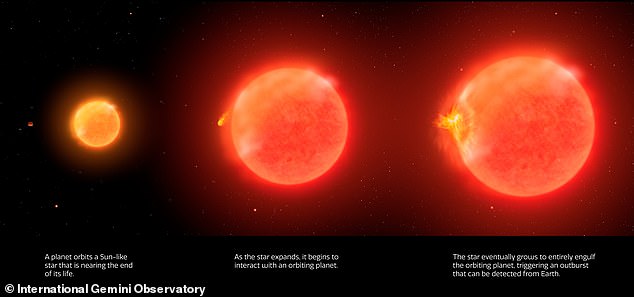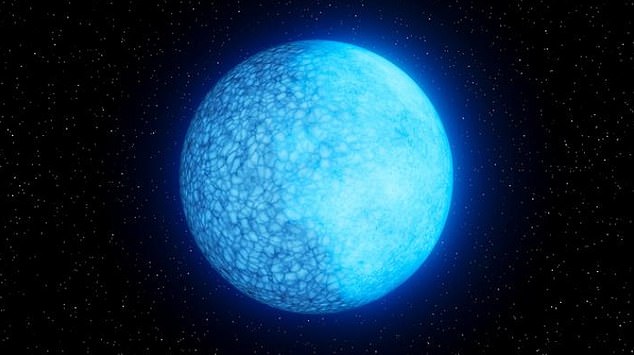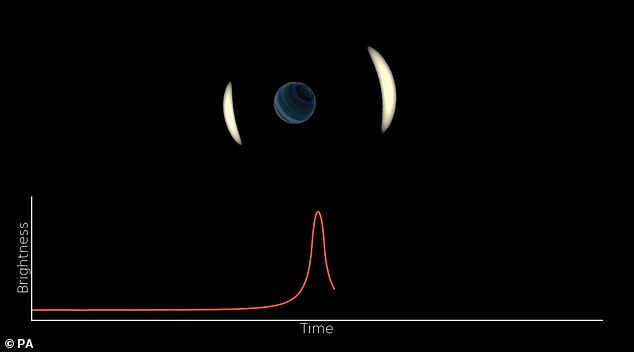New research provides a terrifying glimpse into how Earth will end
Astronomers have discovered a distant, Earth-like planet that offers a chilling glimpse into what our planet could look like billions of years from now.
This newly discovered planet may have once been habitable and orbited a star, similar to how we orbit the sun.
However, the host star suffered a violent death at some point, causing the exoplanet to break free and drift further into space.
Some studies suggest that the sun will begin its death process in about a billion years. When this time comes, our planet may suffer a fate similar to this newly discovered planet.
Astronomers have discovered an Earth-like planet orbiting a white dwarf star 4,000 light-years away. Billions of years from now, our planet could look exactly like this
The new planet and its host star are located near the central bulge of the Milky Way galaxy, about 4,000 light-years away from us, the equivalent of about 40 billion kilometers.
It was first spotted in 2020, but a team of astronomers from the University of California, Berkeley recently looked at this planetary system again using the Keck 10-meter telescope in Hawaii.
Their research revealed that this Earth-sized planet orbits a white dwarf star, or the dense, hot core of a deceased star.
Before the star died, this planetary system may have looked a lot like Earth orbiting the sun. And it’s not impossible that this planet could have supported life billions of years ago.
But today, this rocky, arid planet lies outside the white dwarf habitable zone: the region around a star that is capable of sustaining life.
Our own sun will eventually undergo the same death process. But we won’t live to see it. Studies suggest that our star still has a billion years left in its lifespan.
But the death of the sun will eventually evaporate Earth’s oceans and double the radius of its orbit. And that’s only if the sun’s expansion doesn’t swallow our planet whole first.
When the Sun enters its red giant phase – the last stage before death – it will inflate like a balloon, engulfing and burning Mercury and Venus.

As a star nears the end of its life, it begins to inflate to the red giant stage. Any planets close enough during this process will be swallowed up by the Sun’s expansion

Once the red giant stage ends, the star ‘dies’ and turns into a white dwarf
At the same time, the shrinking mass will cause surviving planets – like Earth perhaps – to widen their orbits.
This offers the Earth a small chance of survival. But it is possible that our planet could be swallowed up along with Mercury and Venus during the Sun’s red giant phase.
“We currently have no consensus on whether Earth can avoid being engulfed by the red giant sun,” lead author Keming Zhang, a postdoctoral researcher at the University of California San Diego, said in a statement.
“In any case, Planet Earth will only be habitable for about a billion years, after which Earth’s oceans will evaporate due to the runaway greenhouse effect – long before they are at risk of being swallowed by the red giant,” he added .
In eight billion years, the Sun will begin its final transformation into a ‘dead’ white dwarf. The outer layers will spread out, leaving behind a dense, glowing ball that is the size of Earth but still has the original mass of the Sun.
If Earth survives the Sun’s red giant phase, it will be about twice as far away from the Sun as it is now. This new orbit will place it well outside the white dwarf’s habitable zone.
This grim picture of our planet’s future looks remarkably similar to the current state of this newly discovered planet.
“This system that Keming found is an example of a planet – likely an Earth-like planet that was originally in a similar orbit to Earth – that survived the red giant phase of its host star,” said co-author Jessica Lu, University associate professor and chair of astronomy. at UC Berkeley, in a statement.
The research team published their findings today in the journal Nature Astronomy.

During a microlensing event, the brightness of the background star is enhanced by a planetary system as they pass each other
Astronomers first spotted this distant planetary system when it passed in front of a more distant star in 2020, magnifying its light a thousandfold.
This is called a ‘microlensing event’. When a planetary system passes in front of a star, the system’s gravity acts like a lens to focus and amplify the light from the background star.
Researchers from the Korea Microlensing Telescope Network analyzed that event and determined that the system consists of a star about half the mass of our Sun, an Earth-sized planet, and another massive planet 17 times as massive is like Jupiter.
They also concluded that the distance between the Earth-sized planet and the star is approximately equal to the distance between the Earth and the Sun.
But the team couldn’t determine what type of star the planets orbited.
To answer that question, Zhang, Lu and their colleague Joshua Bloom – professor of astronomy at UC Berkeley – decided to take another look at this distant planetary system using the Keck II 10-meter telescope in Hawaii.
They observed the system three years after the microlensing event occurred. This timing meant that the background star was no longer magnified and had become so faint that the “lensing” star – the star that is part of the planetary system – should have been visible.
But Zhang and his colleagues saw nothing.
A normal star would have been easy to see. This fact, combined with other known details about the lens star, led the researchers to conclude that it could only be a white dwarf.
“This is a case where seeing nothing is actually more interesting than seeing something,” Lu said.
This study not only provides a unique look at what the distant future of our planet and the Sun might look like, but also underlines the value of closely studying microlensing events.
“Microlensing has become a very interesting way to study other stellar systems that cannot be observed and detected by conventional means,” Bloom said in a statement.
